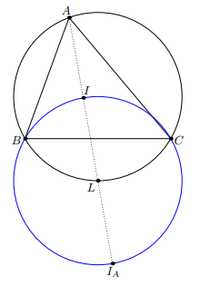Difference between revisions of "Incenter/excenter lemma"
Etmetalakret (talk | contribs) (Created page with "thumb|right|200px|The incenter/excenter lemma. In geometry, the '''incenter/excenter lemma''', sometimes called the '''Trillium theo...") |
Etmetalakret (talk | contribs) m |
||
| (9 intermediate revisions by the same user not shown) | |||
| Line 1: | Line 1: | ||
| − | [[Image:Incenter_excenter_lemma.png|thumb|right|200px| | + | [[Image:Incenter_excenter_lemma.png|thumb|right|200px|Diagram of the configuration.]] |
| − | In [[geometry]], the '''incenter/excenter lemma''', sometimes called the '''Trillium theorem''', is a result concerning a relationship between the incenter and excenter of a triangle. Given | + | In [[geometry]], the '''incenter/excenter lemma''', sometimes called the '''Trillium theorem''', is a result concerning a relationship between the [[incenter]] and [[excenter]] of a triangle. Given any <math>\triangle ABC</math> with incenter <math>I</math> and <math>A</math>-excenter <math>I_A</math>, let <math>L</math> be the midpoint of <math>\overarc{BC}</math> on the triangle's circumcenter. Then, the theorem states that <math>L</math> is the center of a circle through <math>I</math>, <math>B</math>, <math>I_A</math>, and <math>C</math>. |
The incenter/excenter lemma makes frequent appearances in olympiad geometry. Along with the larger lemma, two smaller results follow: first, <math>A</math>, <math>I</math>, <math>L</math>, and <math>I_A</math> are collinear, and second, <math>I_A</math> is the reflection of <math>I</math> across <math>L</math>. Both of these follow easily from the main proof. | The incenter/excenter lemma makes frequent appearances in olympiad geometry. Along with the larger lemma, two smaller results follow: first, <math>A</math>, <math>I</math>, <math>L</math>, and <math>I_A</math> are collinear, and second, <math>I_A</math> is the reflection of <math>I</math> across <math>L</math>. Both of these follow easily from the main proof. | ||
| Line 7: | Line 7: | ||
== Proof == | == Proof == | ||
| − | Let <math>A = \angle BAC</math>, <math>B = \angle CBA</math>, <math>C = \angle ACB</math>, | + | Let <math>A = \angle BAC</math>, <math>B = \angle CBA</math>, <math>C = \angle ACB</math>, and note that <math>A</math>, <math>I</math>, <math>L</math> are collinear (as <math>L</math> is on the angle bisector). We are going to show that <math>LB = LI</math>, the other cases being similar. |
| − | + | First, notice that <cmath>\angle LBI = \angle LBC + \angle CBI = \angle LAC + \angle CBI = \angle IAC + \angle CBI = \frac{1}{2} A + \frac{1}{2} B.</cmath> However, <cmath>\angle BIL = \angle BAI + \angle ABI = \frac{1}{2} A + \frac{1}{2} B.</cmath> Hence, <math>\triangle BIL</math> is isosceles, so <math>LB = LI</math>. The rest of the proof proceeds along these lines. <math>\square</math> | |
| − | |||
| − | + | == See also == | |
| − | + | * [[Orthic triangle]] | |
| − | + | * [[Geometry/Olympiad | Olympiad geometry]] | |
| − | + | ||
| − | + | [[Category:Geometry]] | |
| − | + | [[Category:Theorems]] | |
| − | |||
| − | |||
| − | |||
| − | |||
| − | |||
Latest revision as of 16:31, 18 May 2021
In geometry, the incenter/excenter lemma, sometimes called the Trillium theorem, is a result concerning a relationship between the incenter and excenter of a triangle. Given any ![]() with incenter
with incenter ![]() and
and ![]() -excenter
-excenter ![]() , let
, let ![]() be the midpoint of
be the midpoint of ![]() on the triangle's circumcenter. Then, the theorem states that
on the triangle's circumcenter. Then, the theorem states that ![]() is the center of a circle through
is the center of a circle through ![]() ,
, ![]() ,
, ![]() , and
, and ![]() .
.
The incenter/excenter lemma makes frequent appearances in olympiad geometry. Along with the larger lemma, two smaller results follow: first, ![]() ,
, ![]() ,
, ![]() , and
, and ![]() are collinear, and second,
are collinear, and second, ![]() is the reflection of
is the reflection of ![]() across
across ![]() . Both of these follow easily from the main proof.
. Both of these follow easily from the main proof.
Proof
Let ![]() ,
, ![]() ,
, ![]() , and note that
, and note that ![]() ,
, ![]() ,
, ![]() are collinear (as
are collinear (as ![]() is on the angle bisector). We are going to show that
is on the angle bisector). We are going to show that ![]() , the other cases being similar.
First, notice that
, the other cases being similar.
First, notice that ![]() However,
However, ![]() Hence,
Hence, ![]() is isosceles, so
is isosceles, so ![]() . The rest of the proof proceeds along these lines.
. The rest of the proof proceeds along these lines. ![]()










